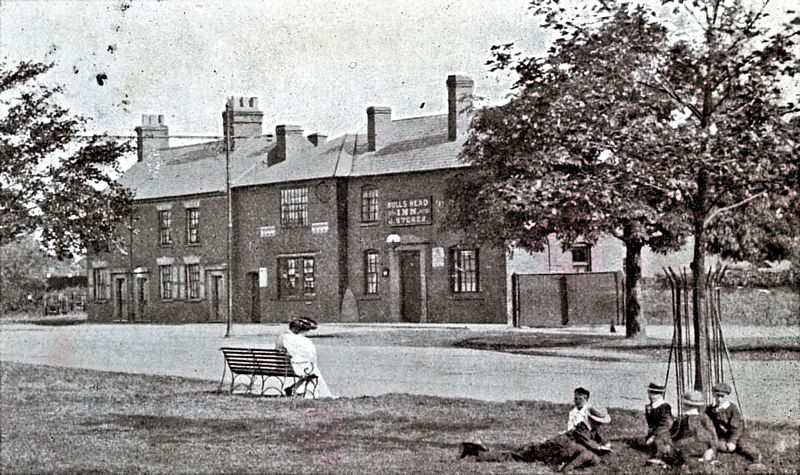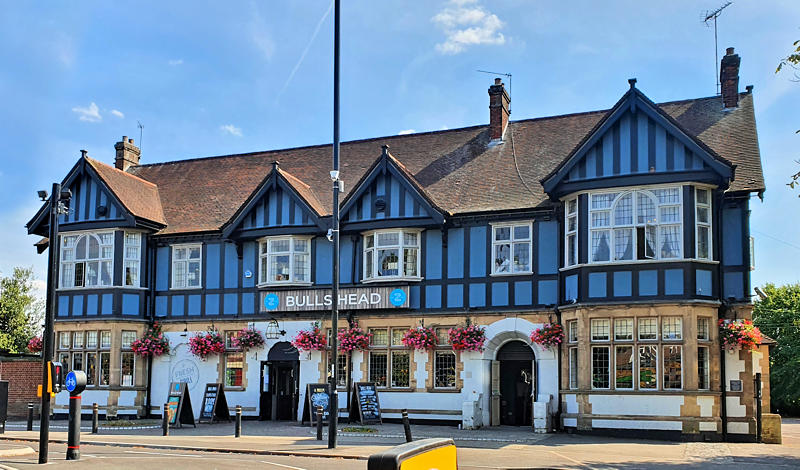Bulls Head, 108 Binley Road, Stoke
| Alternative Addresses: | 37-39 Stoke Green, Stoke, Lower Stoke | ||
 In this wonderful photo from around the turn of the century, this part of what we now know as Binley Road was referred to as Stoke Green. The Bull's Head only occupied the two right-hand properties, numbers 37 & 39, the four to its left, 41 to 47, being private residences.  In February 1921 the Midland Daily Telegraph reported the proposal for new premises to be built on the same site and on land adjoining to the said "Bull's Head Inn". Then, on the 28th June 1926 the license of the old Bull's Head was transferred "to a building erected on land adjoining, and also to the garden bar, lawn and garden". The Fleur de Lis in Smithford Street also closed in order that permission be given to rebuild the Bull's Head. It would appear that the location of the original Bull's Head would be the right-hand end of the current pub premises.
Note that the rural nature of Stoke in the nineteenth century allowed licensees to continue with their everyday jobs, one being a farmer, another a cow keeper.
According to Rev. Blyth in his A History of Stoke, 1897, the well known stocks alongside the pub are said to have been erected in 1848-50 for a man who had got drunk and caused a disturbance. He was fined and told that if the fine was not paid he would be put in the stocks for six hours. He refused to pay but Stoke didn't have any stocks so William Woodward was ordered by the magistrates to build some. Meanwhile, the defendant paid up, and so the stocks were not required! They were, however, used just once some time later, after another drunken disturbance. Henry Woodward was licensee 1876-88, so this appears to have been a local family.
In February 1921 the Midland Daily Telegraph reported the proposal for new premises to be built on the same site and on land adjoining to the said "Bull's Head Inn". Then, on the 28th June 1926 the license of the old Bull's Head was transferred "to a building erected on land adjoining, and also to the garden bar, lawn and garden". The Fleur de Lis in Smithford Street also closed in order that permission be given to rebuild the Bull's Head. It would appear that the location of the original Bull's Head would be the right-hand end of the current pub premises.
Note that the rural nature of Stoke in the nineteenth century allowed licensees to continue with their everyday jobs, one being a farmer, another a cow keeper.
According to Rev. Blyth in his A History of Stoke, 1897, the well known stocks alongside the pub are said to have been erected in 1848-50 for a man who had got drunk and caused a disturbance. He was fined and told that if the fine was not paid he would be put in the stocks for six hours. He refused to pay but Stoke didn't have any stocks so William Woodward was ordered by the magistrates to build some. Meanwhile, the defendant paid up, and so the stocks were not required! They were, however, used just once some time later, after another drunken disturbance. Henry Woodward was licensee 1876-88, so this appears to have been a local family.An ancient and widespread sign which may have begun by referring to a Papal Bull, the leaden seal attached to the Pope's edicts. There may also be a heraldic reference in these signs. Many bull signs are also a reminder that bull-baiting took place. Some signs merely comment on the significance of this animal in farming terms. In nautical terms, a bull is a small keg and in earlier times another nautical expression was "to buill the cask". It meant to pour water into an empty cask, leave it for a while, then drink it. | |||
LICENSEES:1835 - 1846 Mark Bicknell 1846 - 1866 Thomas Pettifor, farmer 1868 - 1874 George Smith, cowkeeper 1876 - 1888 Henry Woodward 1891 - 1892 Fred Hickley 1903 - 1905 John Storer 1908 - 1921 George Edward Wharmby 1921 - 1940 Albert Wharmby 2015 John Thorpe | |||
| Previous page: Bull Inn | This page: Bulls Head | Next page: Bulls Head |